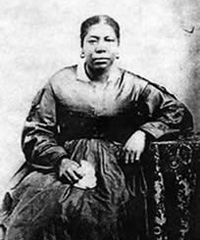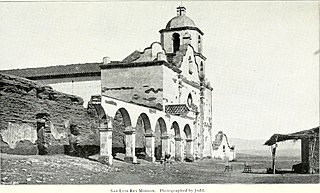
The Utah War (1857–1858), also known as the Utah Expedition, the Utah Campaign, Buchanan's Blunder, the Mormon War, or the Mormon Rebellion, was an armed confrontation between Mormon settlers in the Utah Territory and the armed forces of the US government. The confrontation lasted from May 1857 to July 1858. The conflict primarily involved Mormon settlers and federal troops, escalating from tensions over governance and autonomy within the territory. There were several casualties, predominantly non-Mormon civilians. Although the war featured no significant military battles, it included the Mountain Meadows Massacre, where Mormon militia members disarmed and murdered about 120 settlers traveling to California.

During the history of the Latter Day Saint movement, the relationship between Black people and Mormonism has included enslavement, exclusion and inclusion, and official and unofficial discrimination. Black people have been involved with the Latter Day Saint movement since its inception in the 1830s. Their experiences have varied widely, depending on the denomination within Mormonism and the time of their involvement. From the mid-1800s to 1978, Mormonism's largest denomination – the Church of Jesus Christ of Latter-day Saints – barred Black women and men from participating in the ordinances of its temples necessary for the highest level of salvation, and excluded most men of Black African descent from ordination in the church's lay, all-male priesthood. During that time the LDS Church also opposed interracial marriage, supported racial segregation in its communities and church schools, and taught that righteous Black people would be made white after death. The temple and priesthood racial restrictions were lifted by church leaders in 1978. In 2013, the LDS Church disavowed its previous teachings on race for the first time.

In the United States before 1865, a slave state was a state in which slavery and the internal or domestic slave trade were legal, while a free state was one in which they were prohibited. Between 1812 and 1850, it was considered by the slave states to be politically imperative that the number of free states not exceed the number of slave states, so new states were admitted in slave–free pairs. There were, nonetheless, some slaves in most free states up to the 1840 census, and the Fugitive Slave Clause of the U.S. Constitution, as implemented by the Fugitive Slave Act of 1793 and the Fugitive Slave Act of 1850, provided that a slave did not become free by entering a free state and must be returned to their owner. Enforcement of these laws became one of the controversies which arose between slave and free states.

Christian views on slavery are varied regionally, historically and spiritually. Slavery in various forms has been a part of the social environment for much of Christianity's history, spanning well over eighteen centuries. Saint Augustine described slavery as being against God's intention and resulting from sin. In the eighteenth century the abolition movement took shape among Christians across the globe.

Chief Walkara was a Northern Ute leader of the Utah Indians known as the Timpanogo and Sanpete Band. He had a reputation as a diplomat, horseman and warrior, and a military leader of raiding parties in Wakara's War.

The Poland Act of 1874 was an act of the US Congress that sought to facilitate prosecutions under the Morrill Anti-Bigamy Act by eliminating the control members of the Church of Jesus Christ of Latter-day Saints exerted over the justice system of Utah Territory. Sponsored by US Representative Luke P. Poland of Vermont, the Act redefined the jurisdiction of Utah courts by giving U.S. district courts exclusive jurisdiction in Utah Territory over all civil and criminal cases. The Act also eliminated the territorial marshal and attorney and gave their duties to a U.S. Marshal and a U.S. Attorney. The Act also altered petit and grand jury empaneling rules to keep polygamists off juries. By removing Latter-day Saints from positions of authority in the Utah justice system, the Act was intended to allow for successful prosecutions of Mormon polygamists.

The History of Utah is an examination of the human history and social activity within the state of Utah located in the western United States.

The history of slavery in California began with the enslavement of Indigenous Californians under Spanish colonial rule. The arrival of the Spanish colonists introduced chattel slavery and involuntary servitude to the area. Over 90,000 Indigenous peoples were forced to stay at the Spanish missions in California between 1770 and 1834, being kept in well-guarded mission compounds. This has been described as de facto slavery, as they were forced to work on the mission's grounds amid abuse, malnourishment, overworking, and a high death rate. Indigenous girls were taken from their parents to be housed in guarded dormitories known as monjeríos for conversion to Catholicism and control over their sexuality.

Slavery among Native Americans in the United States includes slavery by and enslavement of Native Americans roughly within what is currently the United States of America.

During and after the European colonization of the Americas, European settlers practiced widespread enslavement of Indigenous peoples. In the 15th century, the Spanish introduced chattel slavery through warfare and the cooption of existing systems. A number of other European powers followed suit, and from the 15th through the 19th centuries, between two and five million Indigenous people were enslaved, which had a devastating impact on many Indigenous societies, contributing to the overwhelming population decline of Indigenous peoples in the Americas.

Freedom suits were lawsuits in the Thirteen Colonies and the United States filed by slaves against slaveholders to assert claims to freedom, often based on descent from a free maternal ancestor, or time held as a resident in a free state or territory.

The Act in Relation to Service, which was passed on Feb 4, 1852 in the Utah Territory, made slavery legal in the territory. A similar law, Act for the relief of Indian Slaves and Prisoners was passed on March 7, 1852, and specifically dealt with Indian slavery.

Slavery in Florida occurred among indigenous tribes and during Spanish rule. Florida's purchase by the United States from Spain in 1819 was primarily a measure to strengthen the system of slavery on Southern plantations, by denying potential runaways the formerly safe haven of Florida. Florida became a slave state, seceded, and passed laws to exile or enslave free blacks. Even after abolition, forced labor continued.
Slavery in New Mexico existed among the Native American (Indian) tribes prior to the arrival of the first Europeans. In 1542, the Spanish king banned the enslavement of the Indians of the Americas in Spanish colonies, but the ban was mostly ineffective. The enslavement of Indians was common during the Spanish exploration and colonization of New Mexico from 1540 to 1821. Slaves of the Spanish included a few of the Pueblos living in the Spanish colony, but most slaves were captured from other Indian tribes in the region. Women were more valued than men as slaves. Slaves were not only valued for their labour, but were also a prestige item among the more prominent and prosperous of the Spanish colonists. Enslavement of an individual was not always permanent. Slaves, especially women, often gained kinship relationships with their owners. The offspring and descendants of enslaved persons were called genizaros and made up one-third of New Mexico's population in the early 19th century. In the Spanish caste system genizaros had low status, but were important for frontier defense and cultural contacts with Indian tribes. Forced labor and debt peonage were also features of slavery in New Mexico. Some Indians captured and enslaved in New Mexico were sent south to work in Mexican mines or even to distant places like Cuba to work on sugar plantations.
Slavery as it occurred in the borders of what is now the state of Utah has a complicated history. Under Spanish and Mexican rule, Utah was a major source of illegal slave raids by Mexican, Ute and Navajo slave traders, particularly on Paiute tribes. When Mormon pioneers entered Utah, they introduced African slavery and provided a local market for Indian slavery. After the Mexican–American War, Utah became part of the United States and slavery was officially legalized in Utah Territory on February 4, 1852, with the passing of the Act in Relation to Service. It was repealed on June 19, 1862, when Congress prohibited slavery in all US territories.

The Latter Day Saint movement has had varying and conflicting teachings on slavery. Early converts were initially from the Northern United States and opposed slavery, believing that their opposition was supported by Mormon scripture. After the church base moved to the slave state of Missouri and gained Southern converts, church leaders began to enslave people. New scriptures instructing Latter-Day Saints not to intervene in the lives of the enslaved people were revealed. A few enslavers joined the church, and when they moved to Nauvoo, Illinois, they illegally took their enslaved people with them, even though Illinois was a free state.

Civil rights and Mormonism have been intertwined since the religion's start, with founder Joseph Smith writing on slavery in 1836. Initial Mormon converts were from the north of the United States and opposed slavery. This caused contention in the slave state of Missouri, and the church began distancing itself from abolitionism and justifying slavery based on the Bible. During this time, several slave owners joined the church, and brought their enslaved people with them when they moved to Nauvoo, Illinois. The church adopted scriptures which teach against influencing slaves to be "dissatisfied with their condition" as well as scriptures which teach that "all are alike unto God." As mayor of Nauvoo, Smith prohibited Black people from holding office, joining the Nauvoo Legion, voting or marrying whites; but, as president of the church Black people became members and several Black men were ordained to the priesthood. Also during this time, Smith began his presidential campaign on a platform for the government to buy slaves into freedom over several years. He was killed during his presidential campaign.

Wakara's War, also known as Walker's War was a dispute between the Ute people and the Mormon settlers in Utah Valley and surrounding areas. This war is characterized as a string of disputes and skirmishes over property and the land from July 1853 to May 1854. This war was influenced by factors such as religious differences, the slave trade, and the division of the Salt Lake Valley.

Over the past two centuries, the relationship between Native American people and Mormonism has included friendly ties, displacement, battles, slavery, education placement programs, and official and unofficial discrimination. Native American people were historically considered a special group by adherents of the Latter Day Saint movement (Mormons) since they were believed to be the descendants of the Lamanite people described in The Book of Mormon. There is no support from genetic studies and archaeology for the historicity of the Book of Mormon or Middle Eastern origins for any Native American peoples. Today there are many Native American members of Mormon denominations as well as many people who are critical of Mormonism and its teachings and actions around Native American people.

Hark Lay Wales, born in Monroe County Mississippi, was one of the few African Americans to cross the Mormon Trail as a pioneer with members of The Church of Jesus Christ of Latter-day Saints. Hark Lay Wales was a hardworking man who helped the Saints cross the Mormon Trail and arrive in Utah. He acquired his freedom and lived a peaceful life in California until he later returned to Utah. Not much is known about the life of Hark Lay Wales but he was a historic figure for the history of African Americans in the Church of Jesus Christ of Latter-Day Saints.














